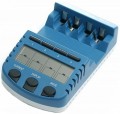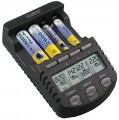The smallest current that the device is capable of providing in battery discharge mode.
Some specific functions are based on the discharge of the battery installed in the charger (see below for more details); in this case, it often becomes necessary to set a certain value of current strength, which is optimal for a given battery. The lower the minimum discharge current (with the same maximum) — the wider the adjustment range and the higher the probability that the device will be able to provide the optimal discharge mode.
The highest current that the device can provide in battery discharge mode.
Some specific functions are based on the discharge of the battery installed in the charger (see below for more details). The higher the maximum value of the discharge current, the less time it takes to “drain” energy from the battery. On the other hand, for some types of batteries and discharge modes, specific current recommendations may be provided, and exceeding them can be fraught with overload, overheating, and even fire. Therefore, it is necessary to specifically pursue high values of the discharge current only if it is justified from a technical point of view.
A system that determines the location of the "plus" and "minus" of the connected battery and determines whether these contacts correspond to the contacts of the charger itself. The capabilities of such systems may be different: some, in the event of an error, issue a warning signal and block the power supply, others are able to automatically switch the polarity on the contacts, depending on which side the battery is installed. In any case,
checking the polarity minimizes the possibility of connection errors and the corresponding consequences.
Short circuit protection function . Such a short circuit can occur both during charging (for example, due to a malfunction of the connected battery or a foreign object getting between the contacts), and during discharging (due to a failure already in the memory itself). In any case, a short circuit leads to a sharp increase in current strength and abnormal loads on equipment, the consequences of which can be breakdowns and fires. To avoid this, short circuit protection is used - usually in the form of a fuse that turns off the power when the current increases sharply. Note that such a fuse can be both reusable and disposable, requiring replacement after operation.
Chargers with a plug for connecting to a socket on the tip of the mains cable. Models
with a plug on the wire provide freedom of placement of the “charger” (especially in cramped free space near the outlet). So that the cable does not get tangled at hand, in many models it is made removable, which makes it easy to store the charger.

